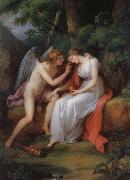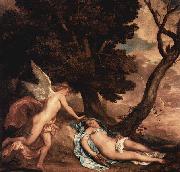Wholesale Oil Painting Reproductions No Minimum and Door to Door! |
|||||||||||
|
|
|||||||||||

|
|||||||||||
|
|
|
||||||||
All Angelika Kauffmann Oil Paintings |
||||||||
|
|
||||||||
|
|
||||||||
|
Artist Introduction: 1741-1807,Swiss neoclassical painter and graphic artist. From her youth she was known for her artistic, musical, and linguistic abilities. She went to England, where she enjoyed success as a fashionable portrait painter and decorator. A protegee of Sir Joshua Reynolds, Kauffman was one of the original members of the Royal Academy. She often decorated houses designed by the Adam brothers. After her marriage in 1781 to the Venetian painter Antonio Zucchi, she lived in Italy, where she flourished in artistic and literary circles. Reynolds, Winckelmann, Goethe, and Garrick commissioned her to paint their portraits. Representative works include Religion (National Gall., London); Self-Portrait (Staatliche Museen, Berlin); and the etchings of L'Allegra and La Pensierosa. The British Museum has a collection of her drawings and prints. |
||||||||
|
|
||||||||
|
Amor und Psyche Painting ID:: 45159 |
mk180
1792
Ol auf Leinwand
215.5x164.5cm
|
|||||||
Height Width |
INS/CM Quality |
|||||||
|
X |
| |||||||
|
|
||||||||
All Anthony Van Dyck Oil Paintings |
||||||||
|
|
||||||||
|
|
||||||||
|
Artist Introduction: Dutch
1599-1641
Anthony Van Dyck Locations
Flemish painter and draughtsman, active also in Italy and England. He was the leading Flemish painter after Rubens in the first half of the 17th century and in the 18th century was often considered no less than his match. A number of van Dyck studies in oil of characterful heads were included in Rubens estate inventory in 1640, where they were distinguished neither in quality nor in purpose from those stocked by the older master. Although frustrated as a designer of tapestry and, with an almost solitary exception, as a deviser of palatial decoration, van Dyck succeeded brilliantly as an etcher. He was also skilled at organizing reproductive engravers in Antwerp to publish his works, in particular The Iconography (c. 1632-44), comprising scores of contemporary etched and engraved portraits, eventually numbering 100, by which election he revived the Renaissance tradition of promoting images of uomini illustri. His fame as a portrait painter in the cities of the southern Netherlands, as well as in London, Genoa, Rome and Palermo, has never been outshone; and from at least the early 18th century his full-length portraits were especially prized in Genoese, British and Flemish houses, where they were appreciated as much for their own sake as for the identities and families of the sitters. |
||||||||
|
|
||||||||
|
|
Amor und Psyche Painting ID:: 70449 |
Medium Oil on canvas
Dimensions Expression error: Missing operand for *198 ?? 190 cm
|
||||||
Height Width |
INS/CM Quality |
|||||||
|
X |
| |||||||
|
|
||||||||
|
Prev Next
|
||||||||
|
|
||||||||
|
Related Paintings to Anthony Van Dyck :. |
||||||||
|
|
||||||||
|
CONTACT US |


